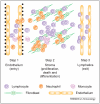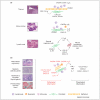A stromal address code defined by fibroblasts
- PMID: 15745857
- PMCID: PMC3121558
- DOI: 10.1016/j.it.2004.11.014
A stromal address code defined by fibroblasts
Abstract
To navigate into and within tissues, leukocytes require guidance cues that enable them to recognize which tissues to enter and which to avoid. Such cues are partly provided at the time of extravasation from blood by an endothelial address code on the luminal surface of the vascular endothelium. Here, we review the evidence that fibroblasts help define an additional stromal address code that directs leukocyte behaviour within tissues. We examine how this stromal code regulates site-specific leukocyte accumulation, differentiation and survival in a variety of physiological stromal niches, and how the aberrant expression of components of this code in the wrong tissue at the wrong time contributes to the persistence of chronic inflammatory diseases.
Figures



References
-
- Campbell DJ, et al. Chemokines in the systemic organization of immunity. Immunol. Rev. 2003;195:58–71. - PubMed
-
- Nakano H, et al. A novel mutant gene involved in T-lymphocyte-specific homing into peripheral lymphoid organs on mouse chromosome 4. Blood. 1998;91:2886–2895. - PubMed
-
- Nakano H, et al. Genetic defect in T lymphocyte-specific homing into peripheral lymph nodes. Eur. J. Immunol. 1997;27:215–221. - PubMed
Publication types
MeSH terms
Grants and funding
LinkOut - more resources
Full Text Sources

